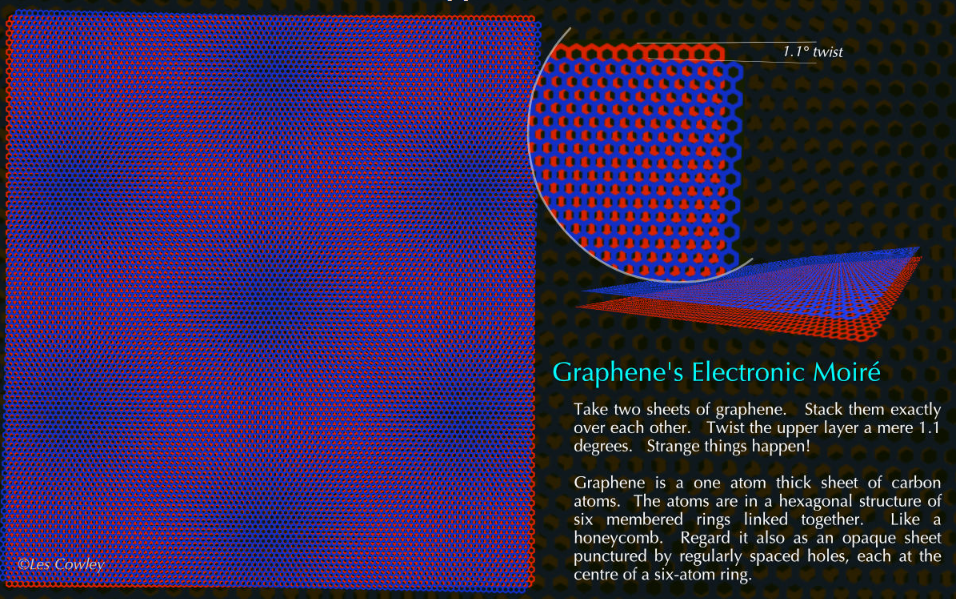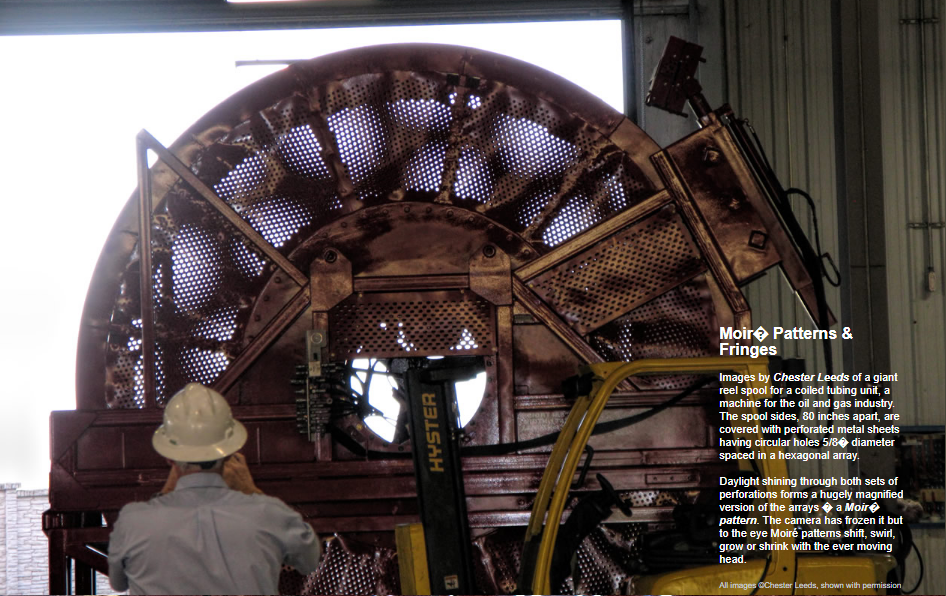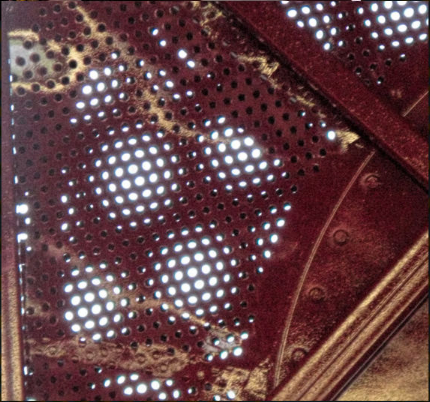Twisted bi-layer graphene moire
Twisted Bi-Layer Graphene Moiré: Exploring the Quantum Phenomenon
Moiré patterns have long fascinated scientists and artists alike. These patterns emerge when two objects with regularly spaced holes or structures are overlaid, resulting in shifting and shimmering shapes of light and dark. While moiré patterns are commonly observed in everyday objects such as mesh screens and fabrics, their occurrence in the realm of quantum physics is a recent discovery that has opened up exciting possibilities.
One particularly intriguing manifestation of moiré patterns is found in twisted bi-layer graphene. Graphene, a one-atom-thick sheet of carbon atoms arranged in a hexagonal lattice, becomes even more captivating when two identical sheets are stacked precisely on top of each other and then twisted by a mere 1.1 degrees. This small twist gives rise to a mesmerizing phenomenon, both optically and electronically.
The electronic moiré effect in twisted bi-layer graphene arises from the interaction between the hexagonal arrays of free-flowing electrons, known as pi-bonds, present above and below the carbon atoms. When the two graphene sheets are perfectly aligned, electrons can transfer between them, leading to interesting quantum effects. Quantum theory calculations predicted that the moiré super-grid resulting from the twist would significantly affect the behavior of individual electrons, causing them to move slowly and interact collectively in what is known as "strongly correlated" behavior.
This prediction was put to the test by researchers who managed to manipulate micron-sized graphene samples and observe the fascinating behavior of twisted bi-layer graphene. The results were nothing short of astounding. When a small voltage was applied between the twisted sheets, they exhibited superconductivity, meaning they could conduct electricity without any resistance. Even more astonishingly, the superconductivity could be switched on and off simply by adjusting the voltage slightly. This discovery opens up new possibilities for the development of fast electronic devices and potentially more reliable quantum computers.
While these experiments were conducted at extremely low temperatures close to absolute zero, they offer a promising path towards understanding high-temperature superconductivity. The behavior of twisted bi-layer graphene's superconductivity is reminiscent of that observed in high-temperature superconductors, which are materials that can exhibit superconductivity at temperatures higher than traditional superconductors. This tantalizing similarity suggests that twisted bi-layer graphene could hold the key to unraveling the mysteries of high-temperature superconductivity and, ultimately, achieving the dream of room temperature superconductors.
Beyond superconductivity, twisted bi-layer graphene also exhibits other intriguing phenomena. The twisted structure gives rise to unusual magnetism, driven by the behavior of the electrons rather than the alignment of atomic spins. This unconventional magnetism adds another layer of complexity to the study of twisted bi-layer graphene and further fuels the excitement surrounding this research topic.
The exploration of twisted bi-layer graphene moiré patterns has sparked a new field of study known as twistronics. Researchers are now extending their investigations beyond graphene and exploring how other materials can be coerced into twisted configurations to observe similar effects. This growing body of research is shedding light on the fundamental principles underlying moiré patterns and their potential applications in various fields, from electronics to quantum computing.
In conclusion, twisted bi-layer graphene moiré patterns offer a captivating glimpse into the world of quantum phenomena. These patterns, resulting from the precise alignment and twist of two graphene sheets, have revealed unexpected behavior, such as switchable superconductivity and unconventional magnetism. By further exploring the intricacies of twisted bi-layer graphene and expanding the study to other materials, researchers hope to unlock new insights into quantum physics and pave the way for groundbreaking technological advancements.

Light and dark moiré patterns from two sheets of "Twisted bi-layer graphene". Each sheet has 'holes' in a regular hexagonal array. Where they overlap is transparent (dark and blue) forming a super-array of light and dark. Plus a super-array of electron configuration.
Graphene's Electronic Moiré
Take two sheets of graphene. Stack them exactly over each other. Twist the upper layer a mere 1.1 degrees. Strange things happen!
Graphene is a one atom thick sheet of carbon atoms. The atoms are in a hexagonal structure of six membered rings linked together. Like a honeycomb. Regard it also as an opaque sheet
punctured by regularly spaced holes, each at the centre of a six-atom ring.



Many everyday objects have regularly spaced holes: mesh screens, grilles, some fabrics, fences. Put two together to see shifting, shimmering and sometimes disconcerting shapes of light and dark. Moiré patterns. Light shines through where holes coincide, elsewhere is dark. The moiré pattern is a super-array. A hugely magnified version of the original hole arrangement. Small relative movement of the sheets move the pattern hugely.
Stack two graphene sheets together. Moiré patterns again, but with a difference. Not visible. Not even optical. Electronic, and weird.
Graphene sheets have a hexagonal array of free flowing electrons (pi-bonds) above and below the carbon atoms. When two sheets are precisely stacked, electrons can transfer between them. Several years ago, quantum theory calculations predicted that when stacked sheets were twisted just 1.1 degrees the resulting Moiré super-grid would choke the flow of individual electrons in the pi bond network. They would instead move very slowly, like cars in a traffic jam. They would interact and behave collectively be 'strongly correlated'. When that happens, strange quantum effects are possible.
Quantum calculations are not easy. Manipulating micron sized graphene slivers is horribly difficult. But last year it was done. With surprising results.
Two twisted sheets became a superconductor when a small voltage was applied between them. Change the voltage slightly and they became an insulator. A switchable superconductor!
That was all close to absolute zero but still a promise of exotic 2D fast electronic devices and
(with other newly seen behaviour) a route perhaps to more reliable quantum computers. More
interestingly still, the superconductivity is rather like that of high temperature superconductors.
"Twisted bi-layer graphene" with its easily voltage controlled superconductivity may be a key to better understanding high temperature superconductivity. That could help towards the holy grail of room temperature superconductors. Power transmission with zero energy loss or unwanted heat.
Or we may have an entirely new kind of superconductivity topological. There is unusual
magnetism too, from electrons rather than aligned atomic spins.
It's is a hot research topic. Other materials are being coerced into twisted sheets. The topic has a name, Twistronics, and has spawned sheathes of research papers. Moiré has come far.
Note: this article has been automatically converted from the old site and may not appear as intended. You can find the original article here.
Reference Atmospheric Optics
If you use any of the definitions, information, or data presented on Atmospheric Optics, please copy the link or reference below to properly credit us as the reference source. Thank you!
-
<a href="https://atoptics.co.uk/blog/twisted-bi-layer-graphene-moire/">Twisted bi-layer graphene moire </a>
-
"Twisted bi-layer graphene moire ". Atmospheric Optics. Accessed on November 26, 2024. https://atoptics.co.uk/blog/twisted-bi-layer-graphene-moire/.
-
"Twisted bi-layer graphene moire ". Atmospheric Optics, https://atoptics.co.uk/blog/twisted-bi-layer-graphene-moire/. Accessed 26 November, 2024
-
Twisted bi-layer graphene moire . Atmospheric Optics. Retrieved from https://atoptics.co.uk/blog/twisted-bi-layer-graphene-moire/.